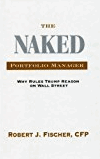“The Best Books on Investing”
The Naked Portfolio Manager
Robert J. Fischer, CFP

The Naked Portfolio Manager makes our best books on investing list because it is simply the most understandable book on behavioral finance and investment decision making available.
Not only does it highlight common errors, it provides techniques to overcome them. Even better, the approach is applicable to almost any endeavor, not just investing.
The goal of the book is to illustrate a superior approach to investment decisions. It is consistent with process improvement methods used in industry today since it relies on developing a consistent, repeatable, measurable approach.
The book consists of four sections
1. The Case for Statistical Decision Making
This section makes the case for deciding how to decide. You can either:
- Analyze available information and reach a buy/sell conclusion based on experience, special knowledge, or intuition – in other words, judgment-based investing. One-of-a-kind decisions dependent on the expert characterize this approach. Or you can
- Pick an algorithm and let the algorithm identify buy/sell conditions based on the available information – in other words, rule-based investing. Consistent, repeatable decisions independent of who uses the algorithm characterize this approach.
Bob Fischer makes an excellent case for the latter. He refers to rule-based, algorithmic decision making as Statistical Decision Making (SDM). NOTE: Don’t worry about the math part – somehow Bob makes it all happen without resorting to lots of math and statistics.
Examples from a variety of disciplines illustrate the difference between clinical (judgment-based) decision making by experts and decision making using algorithms.
2. Common Thinking Errors
This section is worth the price of the book even if you decide not to invest using SDM since the rule-based approach is applicable to any endeavor involving decision making. Other books on investing deal with behavioral finance but in my opinion, not as clearly as this book.
In addition to describing various thinking errors in non-technical language, Bob explains how these errors sabotage investment returns.
The book devotes chapters to each of the following categories of thinking errors:
- Simple decision making errors (aka fuzzy thinking) – 8 distinct types of common errors identified by behavioral finance
- Complex thinking errors – 2 types driven by the quality and quantity of data available to support the decision
- Intractable thinking errors - 2 types of errors that occur because the problem is too large for the human mind
- Confirmation bias errors - several examples of how our blindness to our own shortcomings cripples us
3. Putting SDM into Practice
The introduction is an interesting discussion of the difference between proprietary judgment-based decision making and rule-based decision making.
It reminded me of my personal experience implementing algorithms to replace judgment-based decisions by experienced operators in a manufacturing operation. A few of the operators were superior to their peers but the algorithms out-performed the operators and provided a consistent, measurable outcome. In turn, this led to improvement.
To illustrate the SDM approach, several rule-based strategies are introduced which are readily available to everyone. One strategy is James O’Shaughnessy’s Tiny Titans – described elsewhere on this site. Another is Joel Greenblatt’s Magic Formula Investing described in The Little Book that Beats the Market. These rule-based strategies can be implemented using stock screening.
4. Embracing Nakedness
The book finishes with several useful illustrations regarding selection of rule-based strategies and what performance you can reasonably expect.
Writing the book during the recent market debacle allowed examining the performance of a variety of approaches in real-time. The lesson? Everyone lost money – including SDMs. Eventually every strategy will lose money or under-perform its benchmark.
Conclusions
SDMs are superior to portfolio managers who rely on expertise and/or proprietary models to make judgment-based decisions about your investments.
If an SDM is better than expert clinical judgment, what is the solution? Find rule-based strategies to manage your portfolio investment decisions and implement with stock screening. Partner with a like minded professional or friend for accountability.
This book is a keeper and has value beyond investing. If you don’t own it, buy it
Fischer, Robert J., CFP. The Naked Portfolio Manager: Why Rules Trump Reason on Wall Street (Abbalucci Press, 2009).
About the author of The Naked Portfolio Manager
Bob Fischer is a senior portfolio manager at a national brokerage firm where he uses the statistical decision making approach he describes in his book.
HOME | Site Policies | Contact Us | About Me | About Site | Site Map
Popular Pages
CANSLIM Strategy
Folio Investing
Economic Indicators
Portfolio123
Ranking Systems
New
We value your suggestions, comments, and questions.
Our goal is to make this site as useful as possible.
Contact Us
Thanks!
Stock screening tools and consistent, sustainable investing processes.
About Me
Why build a website instead of a blog?
About this site
Updated Jan 2017